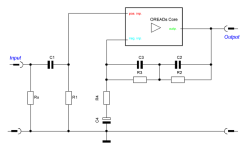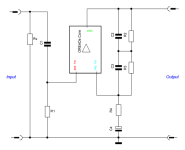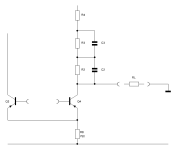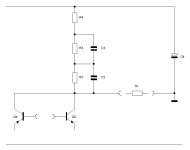ForgottenI don't understand. Isn't Oread a real riia-eq/pre for a real turntable stereo system?
Cheers!
" 😉 "
Oread
Is real and mature, for any kind of MMs.
Are the gerbers in post #23 the "final" version for now? I too have a "cheap" VM95, the shibata version. It certainly holds it's own for the price....
Hello "pfarrell",
I am very pleased with your visit - and as you know, very impressed by your art and profession.
Official Gerber files do not yet exist. Between other popular projects, this experiment should be open in every conceivable direction and that's a huge difference - it encourages you to make your own transfers.
At the moment, the PCB of "catd" represents the latest iteration (in the discovery process). I doubt whether Cat.Design makes files freely available, even if it goes against the spirit of this thread. I stand for the greatest possible transparency.
The three quick PCB designs at the beginning of the thread should be nothing more than illustrative steps along the way.
The first usable PCB is that of the cat. Further suggestions (with the corresponding files, because this "internship" is open) are very welcome.
The evolution is progressing, a final version does not yet exist in my eyes and according to my feeling, but that does not mean that the present version is not already grown up.
OREAD
already more than lives up to its name.
"Herzliche Grüße,
HBt."
I am very pleased with your visit - and as you know, very impressed by your art and profession.
Official Gerber files do not yet exist. Between other popular projects, this experiment should be open in every conceivable direction and that's a huge difference - it encourages you to make your own transfers.
At the moment, the PCB of "catd" represents the latest iteration (in the discovery process). I doubt whether Cat.Design makes files freely available, even if it goes against the spirit of this thread. I stand for the greatest possible transparency.
The three quick PCB designs at the beginning of the thread should be nothing more than illustrative steps along the way.
The first usable PCB is that of the cat. Further suggestions (with the corresponding files, because this "internship" is open) are very welcome.
The evolution is progressing, a final version does not yet exist in my eyes and according to my feeling, but that does not mean that the present version is not already grown up.
OREAD
already more than lives up to its name.
"Herzliche Grüße,
HBt."
Behind my choice of MM system is the little red devil that sits invisibly on my right shoulder, constantly whispering little nasties in my ear.I too have a "cheap" VM95, the shibata version. It certainly holds it's own for the price....
😉
In short:
Audio Technica is and will somehow remain a kind of open and at the same time hidden insider tip, one of many.
I myself wanted to trace the times of the young student and teenager I once was. Hence the AT VM95C with round stylus, the conical cut.
The success of this journey (into the past) has now prompted me to go in search of really good MM systems.
Once you've tasted the forbidden fruit (mine was the green OC3, it took away my innocence - or an Ortofon SPU), you're cursed ..!
So to sum up,
a big yes to the inexpensive MM in its league - an insider tip, always underestimated.
I agree with that.I don't like the concept of an overpriced disposable cartridge.
In principle it is exactly that, as it is often better to buy a new MC cartridge for little more than the price of a retipping and then have a fresh needle suspension again.
I once bought a new Ortofon MC20, which was quite good, until after a few years the needle carrier simply fell out, so I could only throw it away.
There are also good MM systems and I no longer have this great enthusiasm for vinyl to spend so much money on MC.
Is there actually any MC system with a user-replaceable needle?
The retail prices are outrageous (especially in retrospect), absolutely - you could clearly see that with one of my favorites, the Denon DL-103, in decades past.
In production measurement and testing technology, changing the stylus is common practice in the tactile field.
And our pickup is no different.
Bye for today,
HBt.
After the somewhat strange introduction, the guide, once again a more appealing and familiar picture. The first part of the guide shows how to arrive at the theoretical component values.
Now the puzzle game can begin!
But the question of the core, the heart of the equalizer, is perhaps more interesting ...
Now the puzzle game can begin!
But the question of the core, the heart of the equalizer, is perhaps more interesting ...
Attachments
We create a new image - and thus also gain a different perspective and broaden our understanding.
Who cracks the mystery? before moving on to the actual amplifier design, which could obviously just be an integrated operational amplifier - type NE5534 or TL071 or similar.
Who cracks the mystery? before moving on to the actual amplifier design, which could obviously just be an integrated operational amplifier - type NE5534 or TL071 or similar.
Attachments
Please note
the intuitive creation (with limited basic knowledge) of a small signal amplifier only works with the so-called differential amplifier. The procedure shown here is a tentative approach - and the PDFs created very quickly are nothing more than preliminary drafts of a possible form of description.
The present core allows us to digress in many ways and try out all options and decisive improvements, but even in its rudimentary form it is fully functional.
Nevertheless, the reader should feel encouraged to carry out his own experiments and post useful results here.
OREAD is just a start.
the intuitive creation (with limited basic knowledge) of a small signal amplifier only works with the so-called differential amplifier. The procedure shown here is a tentative approach - and the PDFs created very quickly are nothing more than preliminary drafts of a possible form of description.
The present core allows us to digress in many ways and try out all options and decisive improvements, but even in its rudimentary form it is fully functional.
Nevertheless, the reader should feel encouraged to carry out his own experiments and post useful results here.
OREAD is just a start.
The beauty of every design lies hidden in its simplicity - but one of the key secrets is the miracle of negative feedback
Outlook:
The following processing of the guide will be exclusively in English and will provide the missing answers - not just commands. However, this is a larger and more demanding task. I therefore ask for your patience.
In the meantime, OREADs can already be built in abundance. So far only the users "Catd & HBtaudio" have built the p-n-p overkill version, so they have done their duty. Their EQ is one of the four possible basic options. Each of the options is guaranteed to work - sounding different and unique, especially when compared to an IC used.
kind regards,
HBt.
Outlook:
The following processing of the guide will be exclusively in English and will provide the missing answers - not just commands. However, this is a larger and more demanding task. I therefore ask for your patience.
In the meantime, OREADs can already be built in abundance. So far only the users "Catd & HBtaudio" have built the p-n-p overkill version, so they have done their duty. Their EQ is one of the four possible basic options. Each of the options is guaranteed to work - sounding different and unique, especially when compared to an IC used.
kind regards,
HBt.
Error:
UR8 = (R3*0.5mA) - 0.7V = 1.45V
To calculate R8, the corresponding current is still missing. In short: Doubling, 2 * I of the first stage, leads to 2mA.
1,45V / 2mA = 725Ω
We approximate this value according to the E24 series and select the value 750Ω for R8.
Note
The QREAD document is also in an evolving state. The approach is identical to the motto, the leitmotif of this thread. I therefore urge caution or cooperation.
Correction:UR8 = (4.3V - 0.7V) = 3.6V
To calculate R8, the appropriate current is still missing. In short: doubling, 2 * I of the first
stage, leads to 2mA.
R8 = 1.8kΩ we even find this value directly in the E-series.
UR8 = (R3*0.5mA) - 0.7V = 1.45V
To calculate R8, the corresponding current is still missing. In short: Doubling, 2 * I of the first stage, leads to 2mA.
1,45V / 2mA = 725Ω
We approximate this value according to the E24 series and select the value 750Ω for R8.
Note
The QREAD document is also in an evolving state. The approach is identical to the motto, the leitmotif of this thread. I therefore urge caution or cooperation.
Dear reader,
The template you have discovered through play contains a few secrets.
With the degree of abstraction and simplification applied so far, it seems to me that revealing these is not trivial. Every simplification of a circumstance is always not entirely true, depending on one's own perspective. Often, strictly speaking, it is even wrong. Unfortunately, this is the case with the reductions that have to be made if you want to describe something in a way that is appropriate for the target audience. For the current state of the script (the guide, which contains nothing more than notes and perhaps points the way), any further editing means an enormous deepening and thus also a sometimes drastic correction of the previous simplifications.
Is that what you want? Then the script will ultimately become a textbook on applied electronics. However, there have been quite good copies of these on the market for decades. This work is hardly worthwhile.
kind regards,
HBt.
The template you have discovered through play contains a few secrets.
With the degree of abstraction and simplification applied so far, it seems to me that revealing these is not trivial. Every simplification of a circumstance is always not entirely true, depending on one's own perspective. Often, strictly speaking, it is even wrong. Unfortunately, this is the case with the reductions that have to be made if you want to describe something in a way that is appropriate for the target audience. For the current state of the script (the guide, which contains nothing more than notes and perhaps points the way), any further editing means an enormous deepening and thus also a sometimes drastic correction of the previous simplifications.
Is that what you want? Then the script will ultimately become a textbook on applied electronics. However, there have been quite good copies of these on the market for decades. This work is hardly worthwhile.
kind regards,
HBt.
To get to the bottom of the mystery, we have to take a different perspective. The dynamic or ac-view - often called small signal analysis.
Perhaps three simplified pictures will help to lift the curtain?
Perhaps three simplified pictures will help to lift the curtain?
Attachments
What makes this approach special?
The RIAA network itself is the so-called working resistor. The core is nothing more than a voltage-controlled current source.
#
If implemented monolithically, the two common ohmic emitter resistors would naturally be current sinks. This will be familiar to many DIY enthusiasts, but the actual why is certainly not.
With a real operational amplifier, the OREAD design would be nothing special. With the very simple five-transistor thing, it is quite unusual, but also well-known.
If there are no more questions or suggestions, I'll stop at this point, especially since the thread creator is now only a ghost. It was never my intention to take the lead here. My appeal is: take the Lego bricks into your own hands and realize your personal EQ.
I would be delighted to see further development of this thread.
Goodbye,
HBt.
The RIAA network itself is the so-called working resistor. The core is nothing more than a voltage-controlled current source.
#
If implemented monolithically, the two common ohmic emitter resistors would naturally be current sinks. This will be familiar to many DIY enthusiasts, but the actual why is certainly not.
With a real operational amplifier, the OREAD design would be nothing special. With the very simple five-transistor thing, it is quite unusual, but also well-known.
If there are no more questions or suggestions, I'll stop at this point, especially since the thread creator is now only a ghost. It was never my intention to take the lead here. My appeal is: take the Lego bricks into your own hands and realize your personal EQ.
I would be delighted to see further development of this thread.
Goodbye,
HBt.
- Home
- Source & Line
- Analogue Source
- Oread - a DIY MM phono approach




